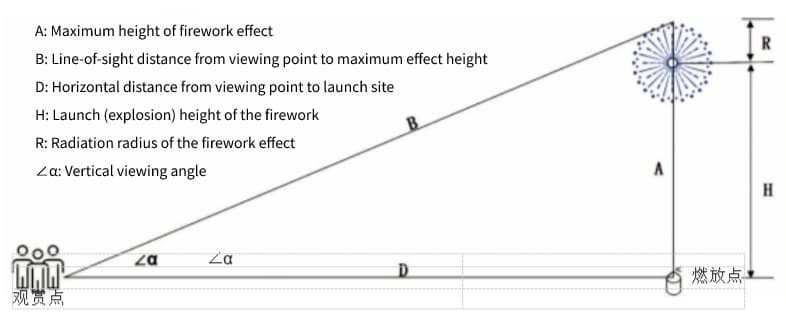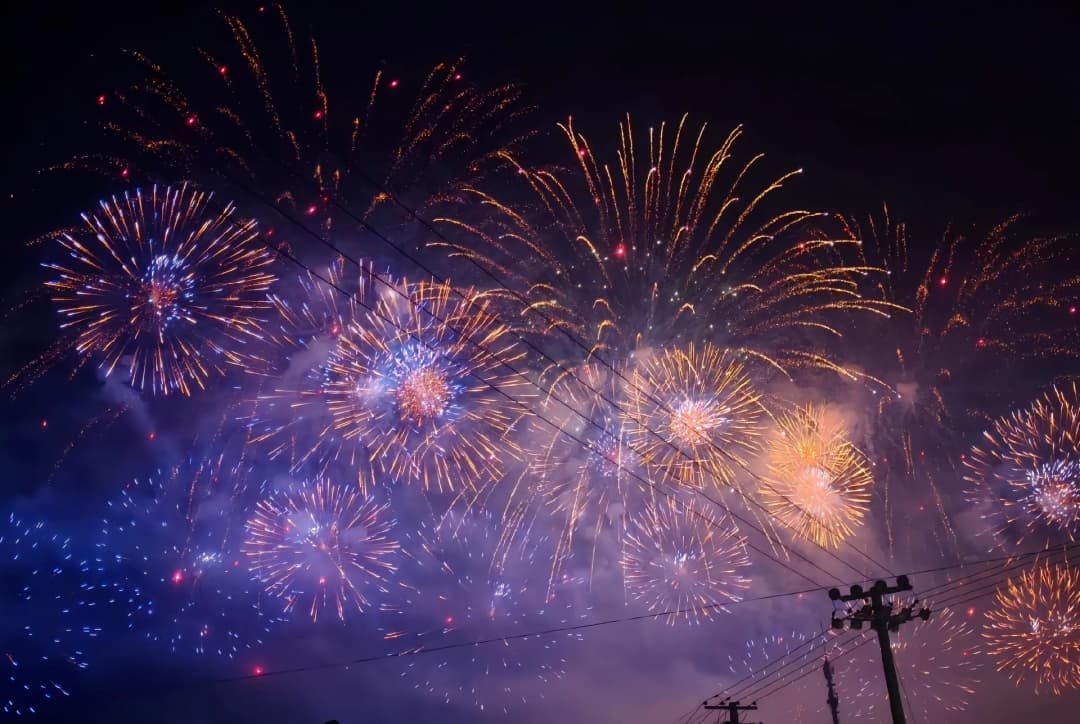A Study on the Optimal Viewing Distance for Large-Scale Fireworks Displays
Large-scale fireworks represent a unique fusion of visual and auditory art, combining sound, light, color, shape, and motion.
In recent years, both the firing techniques and the creative expressions of China fireworks have undergone significant advancements.
Since these fireworks are designed primarily for public enjoyment, it is crucial to consider not only safety distances but also the audience’s visual and auditory experience during the display.
This article analyzes the optimal viewing distance for fireworks based on human visual fields and the physics of sound and light propagation.
Drawing from practical experience in professional displays, we provide reference data that can guide both the audience and display designers in creating the most immersive fireworks experience.

1. Characteristics of Large-Scale Fireworks and Their Viewing Requirements
Professional large-scale fireworks displays typically use advanced products such as small shells, aerial shells, and combination fireworks.
Each category differs significantly in parameters such as launch height and radiation radius. These specifications impact both the required safety distance and the ideal viewing distance.
Table 1: Firework Specs by Type
| Firework Type | Min Explosion Height (m) | Max Explosion Height (m) | Radiation Radius (m) |
|---|---|---|---|
| #3 | 50 | 120 | 25–30 |
| #4 | 60 | 140 | 35–40 |
| #5 | 80 | 190 | 45–55 |
| #6 | 100 | 220 | 55–65 |
| #7 | 110 | 240 | 65–75 |
| #8 | 130 | 260 | 75–85 |
| #10 | 140 | 280 | 85–95 |
| #12 | 160 | 300 | 95–105 |
| Small Shells | 35 | ||
| Combination Fireworks | 35 |
Table 2: Required Viewing Distance by Firework Type
| Firework Type | Viewing Distance (m) |
|---|---|
| #12 | ≥300 |
| #10 | ≥280 |
| #8 | ≥220 |
| #7 | ≥200 |
| #6 | ≥180 |
| #5 | ≥150 |
| #4 | ≥120 |
| #3 | ≥100 |
| Combination Fireworks | ≥50 |
| Small Shells | ≥30 |
The optimal viewing distance is where visual and auditory fatigue is minimized, and the full beauty of the fireworks can be appreciated.
This differs from safety distance, which is intended purely for protection.
2. Viewing Distance Based on Human Visual Field
To ensure spectators can fully observe the entire fireworks scene, calculations must consider both the maximum height and width of the display.
Based on the largest explosion height plus the radiation radius, and with a vertical angle of 35.8°, we can calculate optimal distances.

Table 3: Max Height, Viewing Distance, and Width by Firework Type
| Firework Type | Max Height (m) | Viewing Distance (m) | Max Width (m) |
|---|---|---|---|
| #3 | 150 | 200 | 320 |
| #4 | 180 | 250 | 400 |
| #5 | 245 | 340 | 540 |
| #6 | 285 | 400 | 630 |
| #7 | 315 | 435 | 690 |
| #8 | 345 | 480 | 760 |
| #10 | 375 | 520 | 820 |
| #12 | 405 | 560 | 880 |
| Small Shells | 80 | 110 | 175 |
| Combination Fireworks | 80 | 110 | 175 |
Designers may also use these values to calculate horizontal spread and optimize product placement. For example, in a Level III show using #6 shells with a 400m viewing distance,
a 400m-wide display can be achieved by installing smaller shells at closer distances to add depth.

3. Impact of Sound and Light Propagation on Viewing Distance
Since sound travels slower than light, there can be a lag between what the audience sees and hears.
To maintain sound-light synchronization, it’s recommended to keep the viewing distance within 550 meters.
This is based on the average airborne time of 2 seconds and typical propagation speeds.

4. Conclusion
Ensuring both safety and enjoyment is the foundation of effective fireworks display design.
This article provides initial insights and calculations based on visual field and sound synchronization.
Although simplified, these data points offer practical guidance for real-world China fireworks planning and viewing.
